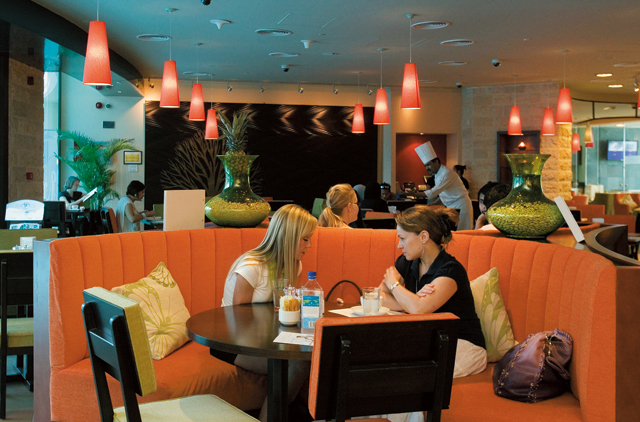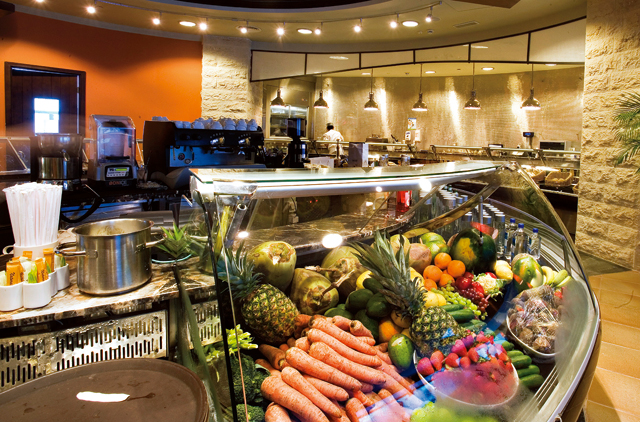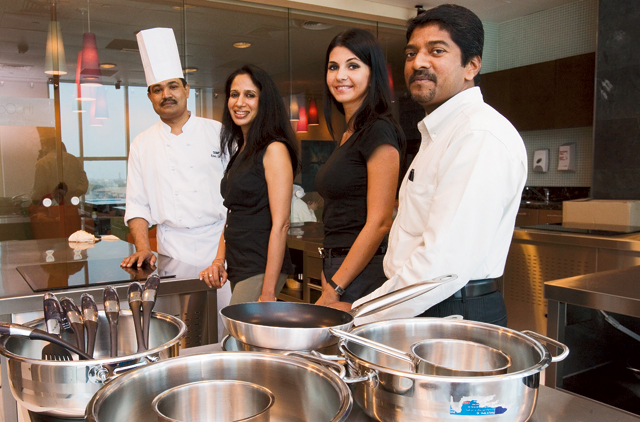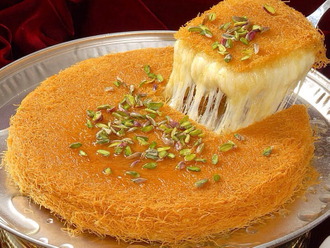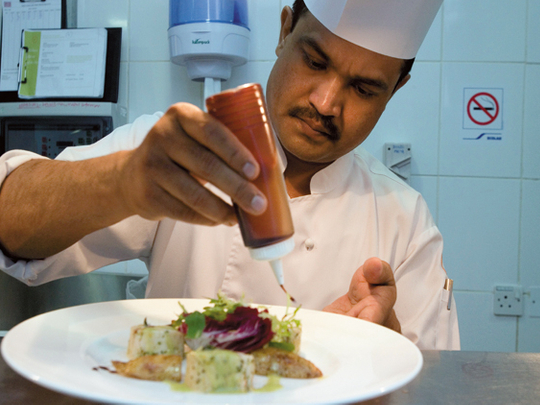
Wellness and balance are feel-good terms.
Not surprisingly then that the new spa coming to town uses these words with maximum impact – Balance Wellbeing 360 club. It is the Landmark Group’s new wellness
concept opening on July 1 in Dubai at the Oasis Centre. The Balance Club draws from ancient wisdom and modern science and emphasises simple but effective methods of eating, exercising and nurturing a positive mental outlook.
The Balance Wellness Club – with spa facilities and a health food café – uses a range of oriental and Western holistic treatments, exercises and nutritional approaches to help you understand your body, mind and spirit so you can rejuvenate yourself. In other words, it seeks to put you back in touch with yourself. At the sprawling club on
level three at Oasis Centre with its soothing environs, a group of experts takes you under their wings.
Dr Chandy George, the specialist Ayurveda doctor with 15 years of experience in Ayurvedic treatments, is the Club’s diagnostic nucleus. A few minutes in his company and I am stunned by his accurate description of my physical and emotional temperaments. Truth is, all he does is read your pulse using three fingers. What follows is a listing of your physical and mental conditions that is spot on. The pulse diagnostic method is an ancient Ayurvedic method called nadi pariksha. (Nadi is pulse in Sanskrit and pariksha means examination).
Providing mind-body solutions
Dr George is only too aware of the demands our modern, fast-paced lifestyle places on us and its often debilitating results. His line of treatment includes identifying, preventing, controlling, containing and reversing the disease processes caused by lifestyle, metabolic problems, ageing and stress-generated disorders.
In offering custom-made solutions for his clients, Dr George takes into account the individual’s mental, physical and emotional facets as well as the environment he or she operates in.
Once Dr George has come up with a diagnosis, wellness manager Sabrina Martorana guides you through the recommended treatment line. An accomplished therapist in oriental and Mediterranean therapies, she designs a health and fitness routine that could include, yoga, Pilates, chakra-balancing treatments, gym workouts, weight training, personal training or any other relaxing treatments you might need. The person’s body type determines the line of treatment.
Once this is done, you could either choose to follow the recommendations on your own or enrol as a Balance Club member.
The Balance Café adjoining the Club is already attracting health-conscious diners with its wonderful selection of breakfast, lunch, dinner and snack offerings – that are friendly the pocket too. Breakfasts at Balance Café don’t cost more Dh15 per person, while lunch is well within Dh25.
The multi-cuisine menu is based on Ayurvedic principles and uses contemporary cooking styles and organic ingredients wherever possible. The mastermind behind Balance Café’s healthy menu is executive chef Sumit Kumar, from India’s famous destination spa Ananda situated at the foot of the Himalayas.
Kumar says, “Balance Café’s underlying philosophy is to blend one’s physical, mental and emotional well-being to achieve perfect alignment and vibrant health.
It uses fresh ingredients and dishes are cooked according to Ayurveda’s Rasa theory. The Rasa theory states that the six basic flavours in food – sweet, sour, salty, bitter, pungent and astringent – play a role in leading an individual to a perfect state of well-being.
“A balanced diet incorporating all six flavours in the right proportions is the key to good physical health and a happy mind.”
A restful haven to recharge your batteries
The café also has a reading area, starters section, bakery and pastry section and a drinks and juice counter is a great place to nourish the body and mind in a relaxing environment. The library offers a good selection of books on food, life sciences, Ayurveda and healthy cooking. “The café has been designed to provide a value-added experience to every one who visits it,” says Ira Malik, COO of the Landmark Group’s hospitality division.
“It offers a holistic approach to eating through blending taste, health and affordability. It brings together the benefits of Ayurvedic cooking techniques and contemporary wellness based on macrobiotic nutrition.
It also fills the gap in this market between places that offer strict diet foods and those with gourmet offerings,” she adds.
The menu, featuring healthier and lighter preparations created using local, European, Indian and Japanese ingredients, has a chart detailing the benefits of various food groups, allowing you to select your meal based on your physical and emotional requirements.
I tried their gluten-free mini dosa and sugar-free pastry and found both equally appealing to my taste buds. For those with food intolerances or allergies, the café has plenty of delicious gluten-free and dairy-free options to satisfy your needs.
There are also plans to launch a cooking school, says Kumar. Using simple techniques and easy-to-find ingredients, the courses will provide recipes that can be recreated at home as well as a meal delivery service that will enable patrons to order in monthly meals that are tailored to suit their needs.
Inside info
Membership fee: From Dh800 per month.
Benefits include: Consultation with an Ayurvedic consultant and senior experts.
Contact: info.balance@cplmg.com
What are chakras?
- They are the seven energy centres in the body that receive energy from the universe and regulate its flow through the body.
- The seven chakras are: the crown chakra, the third eye chakra, the throat chakra, the heart chakra, the solar plexus chakra, the sacral chakra and the root/base chakra, all located on points along the central meridian of the body. They start from the base of the spine and go through the spinal column towards the head.
- Blockages or other energy dysfunctions in the chakras results in disorders in the body, mind and spirit.
- Healers trained to cleanse the chakras through exercise, breathing techniques or right nutrition, work on them and rebalance the energy flow.
(Information courtesy: Dr Chandy George, Balance Wellbeing 360 Club.)
Know your dosha
According to Ayurveda, an individual’s temperament and disposition is determined by the balance of the five elements – air, water, space, ether and fire. These elements combine in various percentages to form three doshas – vata (air), pitta (bile) and kapha (phlegm).
A person’s disposition is shaped by the predominant dosha. Those who have vata as their main dosha are quick and lively in thought, speech and action, and make friends easily; the pitta types are sharp and determined in thought, speech and action; and those whose main dosha is kapha are stable and calm in thought, speech and action.
Vata
What it means: That which moves things. It is the moving force behind the other two doshas, which are incapable of movement without it.
Responsible for: All the body’s activities including breathing, blood circulation and thought processes.
What it does: Promotes mental balance and comprehension.
Pitta
What it means: That which digests things.
Responsible for: All chemical and metabolic transformations in the body and heat production. It also governs our ability to digest ideas and impressions and to perceive the nature of reality.
What it does: Stimulates the intellect and kindles the capacity for enthusiasm.
Kapha
What it means: That which holds things together.
Responsible for: Offering resistance against disease; can support the healing process.
What it does: Provides support and substance to the body. It gives strength and stability, both physical and psychological, and governs human emotions such as love and compassion.
The Rasa theory
Rasa means flavours or tastes. The flavours in foods balance the energies in the body. According to Ayurveda, each food has a medicinal value and good digestion is the path to optimal health.
The six food rasas are sweet, sour, salty, pungent, bitter and astringent. Each plays an important role in moderating the body’s metabolism, catabolism and anabolism.
Our diet should include all six flavours and macronutrients like protein, fats and carbohydrates in every meal. Since each type of food has a unique effect on digestion, metabolism and the formation of tissues, a diet that is not balanced can lead to health problems, craving for certain foods, excessive hunger, fatigue or tiredness after a large meal.
A person who is moderate to highly active needs to eat a meal that is based on 55 to 60 per cent carbohydrates, 20 to 25 per cent protein and 15 to 20 per cent fats.
The Wellness Club emphasises the 6x nutrition method of eating where the total caloric intake for a day is broken down into six meals as opposed to three meals. This could be the key to lifelong weight management as it can lead to weight loss without an increase in physical activity. Also regular intake of food throughout the day evens out the flow of insulin, preventing peaks and valleys, a phenomenon that leads to hunger pangs.
Main functions of tastes (Rasa)
Sweet Increases body tissue volume.
Sour Improves appetite.
Salty Makes the body supple and cleanses tissues.
Pungent Reduces fluid retention in the body.
Bitter Purifies organs and controls skin ailments.
Astringent Purifies and tightens flaccid body parts.


